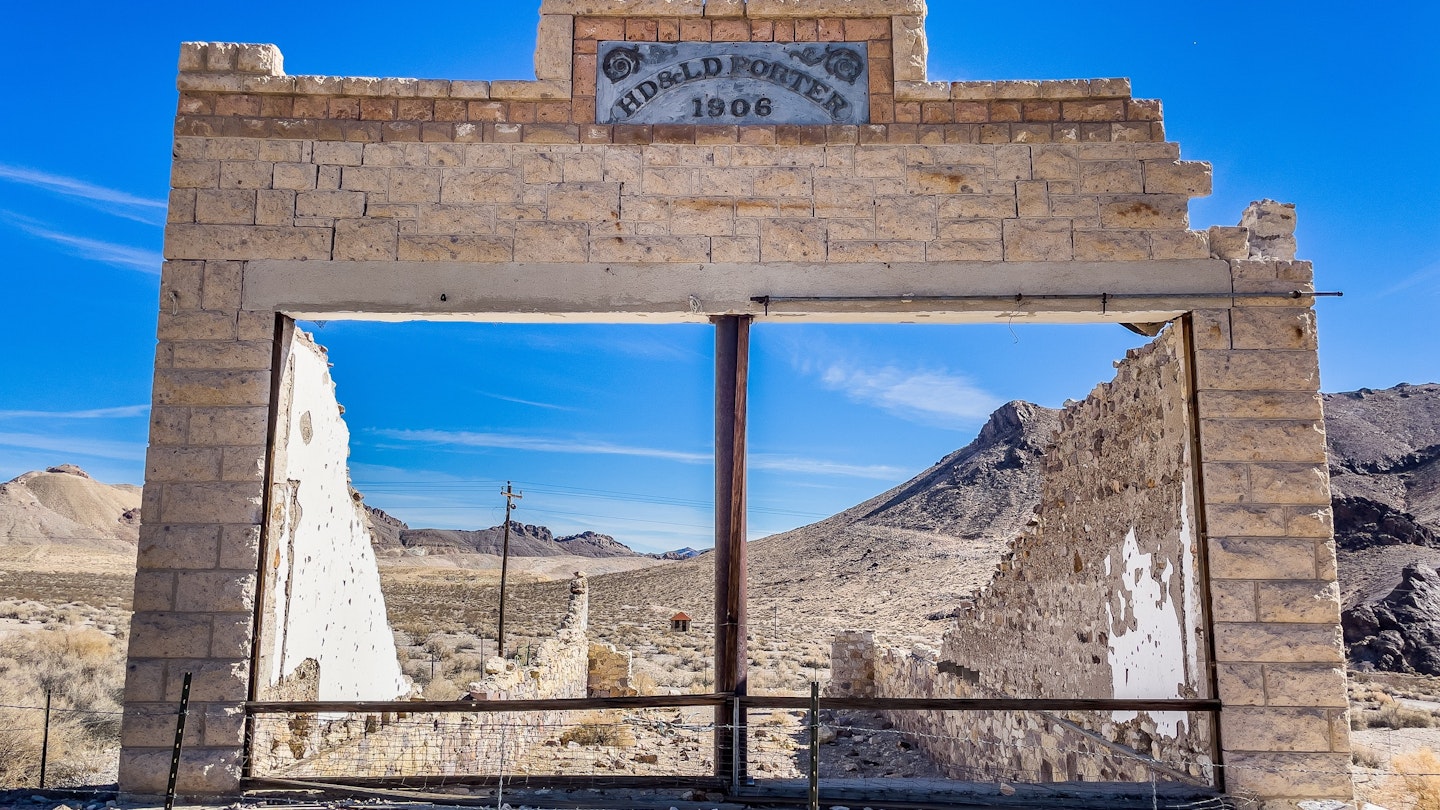Discover Ghost Towns in Nevada
Ghost towns occupy a unique place in the American psyche as haunting reminders of the booms and busts that irrevocably changed the West – and the country as a whole.
Nevada harbors more ghost towns than populated ones, and many of them are home to (or located near) another Silver State icon: the Sagebrush Saloon, a distinctly Nevadan watering hole that has kept folks well-hydrated for centuries.
For the ultimate ghost town trip, spend your days exploring these Nevada landmarks beneath the desert sun and your evenings wetting your whistle while the saloon bartender spins you a yarn.
Rhyolite

Perched on the edge of Death Valley like a spectral sentinel, Rhyolite is one of Nevada’s best-known and most photographed ghost towns. Established in 1905, the town cropped up as part of the Bullfrog Mining District – so named for the area’s gold-flecked rocks, which prospectors agreed looked distinctly amphibious due to their size, color, and texture.
At its height, it was home to (by some estimates) 10,000 people and more than 30 saloons, 20 lodging houses, a hospital, a school, a train depot, and all the trappings of a permanent town. However, like so many Gold Rush towns across the state, its wealth was short-lived; the boom itself only lasted for about four years, and the entire town was empty by 1916.
Today, Rhyolite only has one resident: caretaker Carl Olson.

“I have the privilege of being able to drive the streets because I know where all the historic ruins are,” says Olson, who works for Nevada’s Bureau of Land Management. “It comes alive to me. I’ll pick a different street each time [I go out] – drive through the red-light district, where the assayers were. What fascinates most people is how large Rhyolite was, and then it was just gone like that.”
Visitors can walk along the dusty streets, taking in the town’s ruined walls and foundations with the stark Death Valley serving as an expansive backdrop. Stop by the remains of the stately town bank, wander past the Old Miner’s Union Hall, or walk up to the Spanish-style train depot, which used to welcome three different railway lines – hard to imagine now, when the only way into Rhyolite is a gravel road. Don’t miss the Tom T. Kelly Bottle House, a residence built entirely out of glass bottles gathered from the saloons in their heyday. If you look closely, you can see what libations folks were drinking out there in the desert.
Goldfield

A fascinating crossroads between old and new, Goldfield is a “living ghost town,” a rural Nevada community dotted with ruined (and some not-so-ruined) landmarks from the town’s Rush days. At its peak, Goldfield was home to 20,000 people and was the biggest town in the state.
According to John Ekman, president of the Goldfield Historical Society, preserving the town’s long history is crucial.
“My idea of a living ghost town would be one where there are a lot of unused buildings dating back to an early period,” says Ekman. “There are still people living in Goldfield, but there are a lot of large buildings – like the old high school – which are totally unused and basically look like they did when they were brand new.”

Visitors ready to explore Goldfield can head out on the self-guided Goldfield Historic Walking Tour. Don’t-miss stops include the tumbledown cottages on Franklin Avenue, the Esmeralda County Courthouse, the historic cemetery, and the Goldfield Red Light District. If you’re looking for a taste of the supernatural, peer into the windows of the historic Goldfield Hotel. Rumored to be haunted by tormented spirits, some supernaturalists believe the property is the portal to Hell. That’s quite a superlative, if you ask us.
The Ghost Towns of the Big Smoky Valley
Follow Highway 376 north out of Tonopah, and you’ll find mile after mile of stunning Nevada countryside – the state is the most mountainous in the country, beating out Rocky Mountain favorites like Colorado and Wyoming. This route takes you through the Big Smoky Valley, buttressed by the Toiyabe and Toquima Ranges, and it contains several ghost towns ready for exploring. Manhattan, Belmont, and Ophir Mill all make for evocative stops in this picturesque part of the state. (Note: visiting Ophir Mill requires a high-clearance vehicle.)
While you’re there: Lucky Spur Saloon

If you dream of sipping a cold drink in a place where there’s nothing but land and sky, pop into the Lucky Spur. This cozy saloon sits at the entrance to Kingston, population 94 – it’s been named the Best Bar in the Middle of Nowhere, and we have to agree. What it may lack in history (Lucky Spur was built in 2007), this Sagebrush Saloon makes up for in character and a signature Bunker Hill Bloody Mary. This saloon was constructed entirely out of reclaimed wood and its welcoming bar sits in front of a huge window revealing the hills and peaks that frame the Big Smoky Valley.
For owner Robyn Veach, the Lucky Spur is an important hub for both locals and visitors. “This is the center of Kingston, where everyone comes. We support the volunteer firefighter department by owning this bar, we support our kids. This is where everyone comes for birthdays; we’ve had baby showers,” says Veach. “Sometimes it’s about the journey, not the destination, and until you’ve been here you won’t understand. [The Lucky Spur] is the journey and the destination.”




